2016 October Cisco Official New Released 400-101 Dumps in Lead2pass.com!
100% Free Download! 100% Pass Guaranteed!
As a professional IT exam study material provider, Lead2pass gives you more than just 400-101 exam questions and answers. We provide our customers with the most accurate study material about the 400-101 exam and the guarantee of pass. We assist you to prepare for 400-101 certification which is regarded valuable the IT sector.
Following questions and answers are all new published by Cisco Official Exam Center: http://www.lead2pass.com/400-101.html
QUESTION 601
Refer to the exhibit. R1 is not learning about the 172.16.10.0 subnet from the BGP neighbor R2 (209.165.202.130). What can be done so that R1 will learn about this network?
A. Disable auto-summary on R2.
B. Configure an explicit network command for the 172.16.10.0 subnet on R2.
C. Subnet information cannot be passed between IBGP peers.
D. Disable auto-summary on R1.
Answer: B
Explanation:
By default, BGP does not accept subnets redistributed from IGP. To advertise and carry subnet routes in BGP, use an explicit network command or the no auto-summary command. If you disable auto-summarization and have not entered a network command, you will not advertise network routes for networks with subnet routes unless they contain a summary route.
QUESTION 602
Refer to the exhibit. After a link flap in the network, which two EIGRP neighbors will not be queried for alternative paths? (Choose two.) 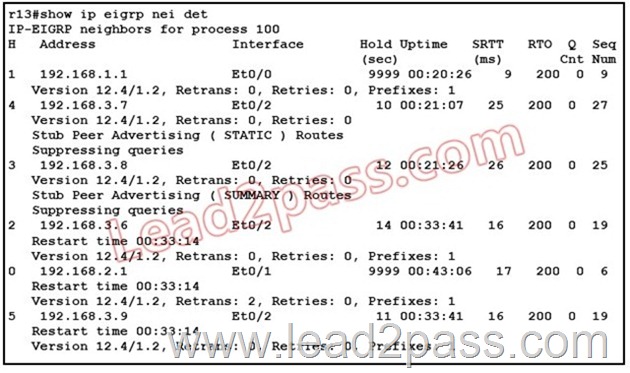
A. 192.168.1.1
B. 192.168.3.7
C. 192.168.3.8
D. 192.168.3.6
E. 192.168.2.1
F. 192.168.3.9
Answer: BC
Explanation:
Both 192.168.3.7 & 192.168.3.8 are in an EIGRP Stub area
The Enhanced Interior Gateway Routing Protocol (EIGRP) Stub Routing feature improves network stability, reduces resource utilization, and simplifies stub router configuration. Stub routing is commonly used in a hub and spoke network topology. In a hub and spoke network, one or more end (stub) networks are connected to a remote router (the spoke) that is connected to one or more distribution routers (the hub). The remote router is adjacent only to one or more distribution routers. The only route for IP traffic to follow into the remote router is through a distribution router. This type of configuration is commonly used in WAN topologies where the distribution router is directly connected to a WAN. The distribution router can be connected to many more remote routers. Often, the distribution router will be connected to 100 or more remote routers. In a hub and spoke topology, the remote router must forward all nonlocal traffic to a distribution router, so it becomes unnecessary for the remote router to hold a complete routing table. Generally, the distribution router need not send anything more than a default route to the remote router.
When using the EIGRP Stub Routing feature, you need to configure the distribution and remote routers to use EIGRP, and to configure only the remote router as a stub. Only specified routes are propagated from the remote (stub) router. The router responds to queries for summaries, connected routes, redistributed static routes, external routes, and internal routes with the message “inaccessible.” A router that is configured as a stub will send a special peer information packet to all neighboring routers to report its status as a stub router. Any neighbor that receives a packet informing it of the stub status will not query the stub router for any routes, and a router that has a stub peer will not query that peer. The stub router will depend on the distribution router to send the proper updates to all peers.
QUESTION 603
Refer to the exhibit. Why is AS 65333 in parentheses? 
A. It is an external AS.
B. It is a confederation AS.
C. It is the AS of a route reflector.
D. It is our own AS.
E. A route map has been applied to this route.
F. The BGP next hop is unreachable.
Answer: B
Explanation:
The AS numbers that are part of the confederation are grouped between parentheses and are replaced by the confederation identifier (the real AS number) in nonconfederation eBGP sessions. .
QUESTION 604
Refer to the exhibit. Which action would make the router the active VRRP router? 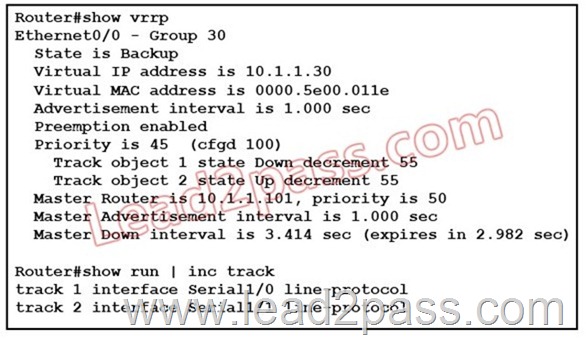
A. Recover interface Serial 1/0.
B. Increase priority in the configuration to 100.
C. Change the interface tracking priority to 100.
D. Recover interface Serial 1/1.
Answer: A
Explanation:
As VRRP Group 30 is configured with preemption all that is required is that the VRRP Priority be higher than that of the current active VRRP router and the current master router priority is 50.
QUESTION 605
Refer to the Exhibit. The displayed QoS configuration has been configured on a router.
IPv6 is being implemented on the router, and it is required to convert the QoS policy to support both IPv4 and IPv6 on the same class.
Which alternative configuration would allow matching DSCP AF41 for both IPv4 and IPv6 on the
same class map? 
A. Class-map match-all CLASS1
Match dscp af41
B. Class-map match-all CLASS1
Match ip dscp af41
Match ipv6 dscp af41
C. Class-map match-any CLASS1
Match ip dscp af41
Match ipv6 dscp af41
D. Class-map match-any CLASS1
Match qos-group af41
Answer: A
QUESTION 606
Voice quality is bad due to high delay and jitter on a link. Which two actions will improve the quality of voice calls? (Choose two.)
A. Increase the queue size of the voice class.
B. Guarantee bandwidth during congestion to the voice class with a bandwidth command.
C. Increase the tx-ring of the egress interface.
D. Implement LLQ for the voice class.
E. Decrease the rx-ring of the egress interface.
F. Decrease the queue size of the voice class.
Answer: DF
QUESTION 607
Refer to the exhibit. On what will the config class-map VOICE match? 
A. only on UDP traffic between port ranges 16384 and 32767
B. only on DSCP EF traffic
C. on UDP traffic between port ranges 16384 and 32767, and on DSCP EF traffic
D. only on EF traffic that is UDP and within the UDP range of 16384 and 32767
Answer: C
QUESTION 608
Refer to the exhibit. Assuming that the routing protocol for this network is EIGRP, if the link between R1 and R3 failed, what would R4 receive from R3? 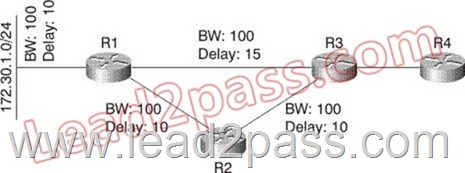
A. R4 would receive an update noting R3’s higher cost to reach 172.30.1.0/24.
B. R4 would not receive any updates or queries, since R3 would simply move to the path through R2.
C. R4 would receive a query, since R3 would mark 172.30.1.0/24 as active when the link between R1 and R4 failed.
D. R4 would not receive any packets, since R3 is not using the link to R1 to reach 172.30.1.0/24.
Answer: A
QUESTION 609
Which three statements accurately describe a link-state routing protocol? (Choose three.)
A. Each router sends routing information to all nodes in the flooding domain.
B. Each router sends all or some portion of its routing table to neighboring routers.
C. Each router individually builds a picture of the entire flooding domain.
D. Each router has knowledge of all other routers in the flooding domain.
E. Each router is only aware of neighboring routers.
F. Each router installs routes directly from the routing updates into the routing table.
Answer: ACD
QUESTION 610
Refer to the exhibit. What is true about the configuration in this exhibit? 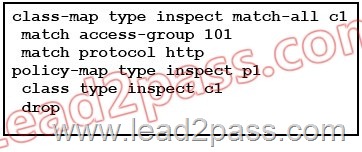
A. It is an invalid configuration because it includes both an application layer match and and a
Layer 3 ACL.
B. It will create a class map that matches the content of ACL 101 and the HTTP protocol, and will
then create an inspection policy that will drop packets at the class map.
C. It will create a class map that matches the content of ACL 101 and the HTTP protocol, and will
then create an inspection policy that will allow packets at the class map.
D. It will create a class map that matches the content of ACL 101 or the HTTP protocol (depending
on the zone of the interface), and will then create an inspection policy that will drop packets at the
class map.
E. It will create a class map that matches the content of ACL 101 or the HTTP protocol (depending
on the zone of the interface), and will then create an inspection policy that will allow packets at the
class map.
F. It is an invalid configuration because the class map and policy map names must match.
Answer: B
QUESTION 611
Refer to the exhibit. You are trying to police down to 100 Mb/s. While testing, you notice that you rarely exceed 70-80 Mb/s. What do you need to change in your MQC configuration to allow for 100 Mb/s speeds? 
A. Change the CIR value from 100 Mb/s to 200 Mb/s.
B. Change the Bc value to allow for a large enough burst.
C. Change the QoS queue from default to priority.
D. Change the exceed-action to transmit.
Answer: B
Explanation:
Burst size–Also called the Committed Burst (Bc) size, it specifies in bits (or bytes) per burst how much traffic can be sent within a given unit of time to not create scheduling concerns. (For a shaper, such as GTS, it specifies bits per burst; for a policer, such as CAR, it specifies bytes per burst.)
QUESTION 612
Which feature would prevent guest users from gaining network access by unplugging an IP phone
and connecting a laptop computer?
A. IPSec VPN
B. SSL VPN
C. port security
D. port security with statically configured MAC addresses
E. private VLANs
Answer: D
QUESTION 613
After applying a new ACL on a device, its CPU utilization rose significantly and many messages
starting with “%SEC-6-IPACCESSLOG” appeared on the Syslog server.
What can be done to resolve this situation?
A. Increase memory allocation for ACLs.
B. Remove all entries from the ACL and use a single permit ip any any statement.
C. Remove the log keyword from each ACL entry.
D. Reboot the device after the ACL has been applied.
Answer: C
QUESTION 614
Refer to the exhibit. Clients that are connected to Fa0/0 of RTA are only allowed to connect to the Internet and networks, but not the networks on Fa1/0, Fa2/0, Fa3/0 and Fa4/0. To achieve this, you have configured an ACL on RTA and applied it on the incoming direction of interface Fa0/0.
After you apply this ACL, you learn that some of these networks are still accessible for clients that are connected to the 10.10.10.0/24 network. What is the correct ACL configuration to solve this
issue? 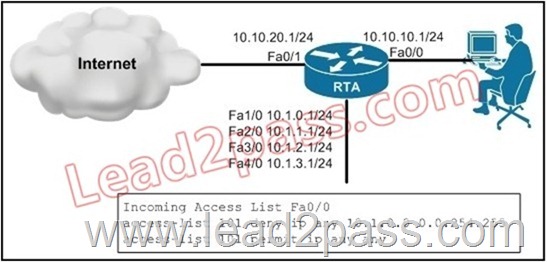
A. access-list 101 deny ip any 10.1.0.0 0.0.1.255
access-list 101 permit ip any any
B. access-list 101 permit ip any 10.1.0.0 0.0.1.255
access-list 101 deny ip any any
C. access-list 101 deny ip any 10.1.0.0 0.0.252.255
access-list 101 permit ip any any
D. access-list 101 deny ip any 10.1.0.0 0.0.3.255
access-list 101 permit ip any any
Answer: D
Explanation:
Access-lists use a wild card mask which is incorrectly configured in the above example Reference
QUESTION 615
You are the network administrator of a medium-sized company, and users are complaining that
they cannot send emails to some organizations. During your troubleshooting, you notice that your DNS MX record is blacklisted by several public blacklist filters. After clearing these listings for your IP address, and assuming that your email server has the right virus protection in place, what are two possible solutions to prevent this from happening in the future? (Choose two.)
A. Change your Internet provider.
B. Change your public IP address.
C. Allow the email server to send traffic only to TCP port 25.
D. Put your email server in a DMZ.
E. Use a separate public IP address for your email server only.
Answer: CE
QUESTION 616
Refer to the exhibit. What can be done to remove the summary routes to Null0 on R3? 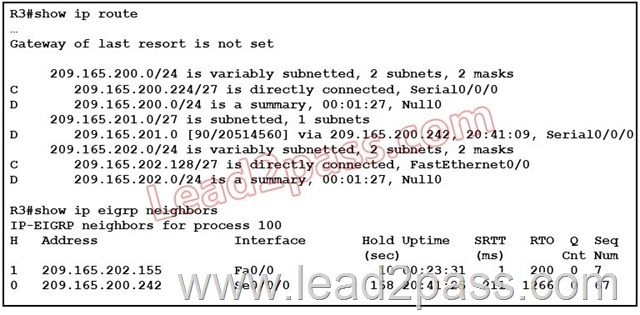
A. Configure the EIGRP routing subcommand no auto-summary on 209.165.202.155.
B. Configure the EIGRP routing subcommand no auto-summary on 209.165.202.24.
C. Configure the EIGRP routing subcommand no auto-summary on both 209.165.202.155 and
209.165.202.242.
D. Configure the EIGRP routing subcommand no auto-summary on R3.
Answer: D
Explanation:
Disabling automatic summarization will remove the Null0 summary route and allow EIGRP to look for a supernet or default route when an EIGRP child route does not match a destination packet.
QUESTION 617
Refer to the exhibit. R4 is configured as a receive-only EIGRP stub, and is adjacent with 209.165.202.139 (R3).
However, R4 is not learning about network 209.165.201.0/27 from R3. What could be the cause
of this issue? 
A. R4 should learn this route from 209.165.200.242, and not from R3.
B. R3 is configured as a receive-only EIGRP stub.
C. R3 and R4 may be using different EIGRP process numbers.
D. R3 and R4 are asymmetrically adjacent neighbors.
Answer: B
Explanation:
Configuring EIGRP Stub Routing
To configure a remote or spoke router for EIGRP stub routing, use the following commands beginning in router configuration mode:
QUESTION 618
Refer to the exhibit. What problem does the debug ip ospf event output from R3 indicate? ![]()
A. 209.165.202.140 and R3 are not both configured as OSPF stubs.
B. 209.165.202.140 and R3 are not configured in the same OSPF area.
C. 209.165.202.140 is configured as a no-summary stub.
D. Transit area OSPF hello packets are not processed by design.
Answer: A
Explanation:
As you can see that the hello packets are mismatched. This means that 209.165.202.140 and R3 are not configured as OSPF stubs.
QUESTION 619
Refer to the exhibit. R4 is a remote office router that is running EIGRP; the decision has been made to change EIGRP to use static EIGRP adjacencies. However, once the configuration change was applied, the adjacency between R4 and 209.165.202.139 (HQ) seems to disappear. What could be the cause of this issue? 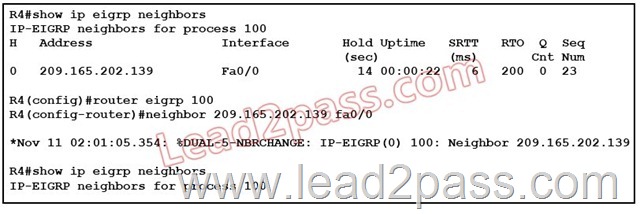
A. Static EIGRP neighbor configuration is symmetric; it causes the interface to stop processing
inbound multicast packets and stop sending multicast packets.
B. Static EIGRP neighbors are not displayed with the show ip eigrp neighbors command.
C. A distance (internal 90 or external 170) must also be configured for the static neighbor.
D. The neighbor 209.165.202.139 should be changed to run under EIGRP autonomous system 0.
Answer: A
Explanation:
As you can see that static EIGRP neighbor configuration is symmetric.
This causes the interface to halt processing inbound packets and stop sending multicast packets.
QUESTION 620
Which EIGRP packet types are sent as unicast packets?
A. hello, update, query
B. query, SIA query, reply
C. SIA query, reply, ACK
D. query, SIA query, SIA reply
Answer: C
QUESTION 621
What is a reason for an EIGRP router to send an SIA reply to a peer?
A. to respond to an SIA query with the alternative path requested
B. to respond to a query reporting that the prefix has gone stuck-in-active
C. to respond to an SIA query that the router is still waiting on replies from its peers
D. to respond to a reply reporting that the prefix has gone stuck-in-active
Answer: C
QUESTION 622
Refer to the exhibit. Which prefixes will appear in the EIGRP topology table? 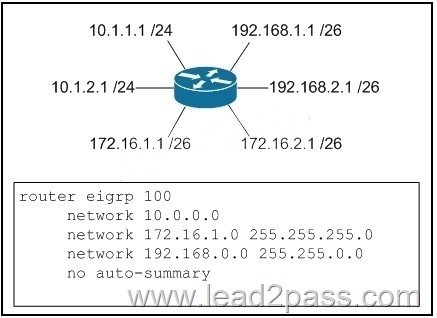
A. 10.0.0.0/8, 172.16.1.0/24, 192.168.0.0/16
B. 10.1.1.0/24, 10.1.2.0/24, 172.16.1.0/26, 192.168.1.0/26, 192.168.2.0/26
C. 10.1.1.0/24, 10.1.2.0/24, 172.16.1.0/26, 172.16.2.0/26, 192.168.1.0/26, 192.168.2.0/26
D. 10.1.1.1/24, 10.1.2.1/24, 172.16.1.1/26, 172, 192.168.1.1/26, 192.168.2.1/26
Answer: B
QUESTION 623
What is the most common use for route tagging in EIGRP?
A. to determine the route source for management purposes
B. to change the metric of a prefix
C. to filter routes in order to prevent routing loops
D. to modify path selection for certain classes of traffic
Answer: C
QUESTION 624
Refer to the exhibit. Which statement is true? 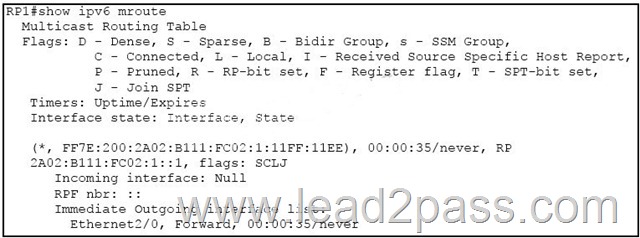
A. The output shows an IPv6 multicast address with link-local scope.
B. The output shows an IPv6 multicast address that is used for unique local sources only.
C. The output shows an IPv6 multicast address that can be used for BIDIR-PIM only.
D. The output shows an IPv6 multicast address with embedded RP.
Answer: D
QUESTION 625
Which two statements about the max-age time in IS-IS are true? (Choose two.)
A. The IS-IS max-age time is 20 minutes by default.
B. The IS-IS max-age time is 60 minutes by default.
C. The IS-IS max-age time increments from zero to max-age.
D. The IS-IS max-age time decrements from max-age to zero.
Answer: AD
Lead2pass.com has been the world leader in providing online training solutions for 400-101 Certification. You use our training materials that have been rigorously tested by international experts.
400-101 new questions on Google Drive: https://drive.google.com/open?id=0B3Syig5i8gpDU2RjeUlHTTZXb1U
2016 Cisco 400-101 exam dumps (All 1219 Q&As) from Lead2pass:
http://www.lead2pass.com/400-101.html [100% Exam Pass Guaranteed]
